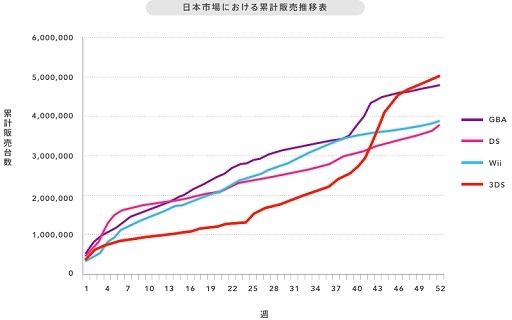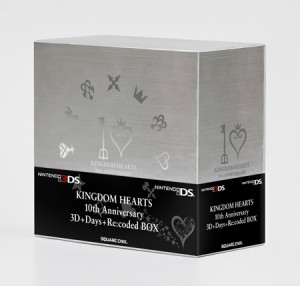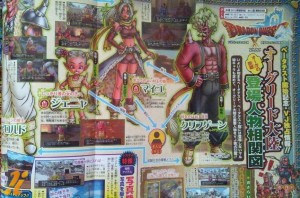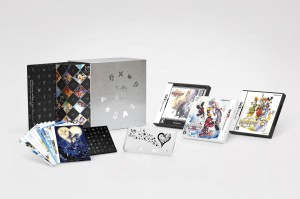Retro City Rampage releasing in May
Posted on 13 years ago by Brian(@NE_Brian) in News, Wii | 0 comments
VBlank Entertainment has been working on Retro City Rampage for quite some time. Finally, though, the game is nearing its completion.
The studio has confirmed that the game will be available in May. It’ll arrive on WiiWare, as well as the PlayStation Network, Vita, and Steam.
3DS sells five million in Japan
Posted on 13 years ago by Brian(@NE_Brian) in 3DS, DS, GBA, News, Wii | 0 comments
The 3DS has sold over five million units in Japan. Nintendo shared the news in an announcement earlier today.
Nintendo’s latest portable is the first system to reach this milestone in 52 weeks. Two other handhelds from the Big N, the DS and GBA, accomplished the feat in 56 and 58 weeks receptively.
Here’s a chart comparing the sales trends for the GBA, DS, Wii, and 3DS:

Thanks to 4Him for the tip!
ESRB updates (2/20/12)
Posted on 13 years ago by Brian(@NE_Brian) in 3DS, DS, News | 0 comments
Gogo’s Crazy Bones (DS) – E
Top Trumps NBA All Stars (3DS/DS) – E
Xia Xia (DS) – E
Silverlicious (DS) – E
Rumor: Nintendo to revive third-parties games for 3DS, Seaman included
Posted on 13 years ago by Brian(@NE_Brian) in 3DS, Rumors | 0 comments
Nikkei published a new report today with regard to Nintendo and third-party titles. Andriasang reports that the company has plans “to revive other publisher’s titles on the 3DS as part of a strategy to bring new strong titles to the system.”
How will Nintendo begin this strategy? By reviving Sea Man of course!
The first Seaman title was released for the Dreamcast. There was a followup for the PlayStation 2, and creator Yoot Saito has hinted at a new Seaman project for 3DS.
We’ll let you know how this rumor develops…
Thanks to 4Him for the tip!
UK software sales (Week ending 2/18)
Posted on 13 years ago by Brian(@NE_Brian) in 3DS, DS, News, Wii | 0 comments
Individual formats
– 1 UFC UNDISPUTED 3 XB360 THQ THQ
– 2 UFC UNDISPUTED 3 PS3 THQ THQ
21 3 MARIO & SONIC LONDON 2012 OLYMPIC GAMES WII SEGA SEGA
10 4 CALL OF DUTY: MODERN WARFARE 3 XB360 ACTIVISION ACTIVISION BLIZZARD
7 5 BATTLEFIELD 3 XB360 EA GAMES ELECTRONIC ARTS
11 6 FIFA 12 XB360 EA SPORTS ELECTRONIC ARTS
15 7 CALL OF DUTY: MODERN WARFARE 3 PS3 ACTIVISION ACTIVISION BLIZZARD
4 8 FINAL FANTASY XIII-2 PS3 SQUARE ENIX SQUARE ENIX EUROPE
8 9 JUST DANCE 3 WII UBISOFT UBISOFT
2 10 THE DARKNESS II XB360 2K GAMES TAKE 2
14 11 BATTLEFIELD 3 PS3 EA GAMES ELECTRONIC ARTS
26 12 MARIO & SONIC LONDON 2012 OLYMPIC GAMES 3DS SEGA SEGA
25 13 SUPER MARIO 3D LAND 3DS NINTENDO NINTENDO
3 14 FINAL FANTASY XIII-2 XB360 SQUARE ENIX SQUARE ENIX EUROPE
19 15 FIFA 12 PS3 EA SPORTS ELECTRONIC ARTS
16 16 ZUMBA FITNESS WII 505 GAMES 505 GAMES
27 17 MOSHI MONSTERS: MOSHLING ZOO DS MIND CANDY MIND CANDY
23 18 MARIO KART 7 3DS NINTENDO NINTENDO
18 19 THE ELDER SCROLLS V: SKYRIM XB360 BETHESDA SOFTWORKS BETHESDA SOFTWORKS
20 20 ZUMBA FITNESS 2 WII 505 GAMES 505 GAMES
1 21 KINGDOMS OF AMALUR: RECKONING XB360 EA GAMES ELECTRONIC ARTS
13 22 ASSASSIN’S CREED: REVELATIONS XB360 UBISOFT UBISOFT
33 23 SKYLANDERS: SPYRO’S ADVENTURE WII SKYLANDERS ACTIVISION BLIZZARD
32 24 FORZA MOTORSPORT 4 XB360 MICROSOFT MICROSOFT
39 25 UNCHARTED 3: DRAKE’S DECEPTION PS3 SONY COMPUTER ENT. SONY COMPUTER ENT.
6 26 METAL GEAR SOLID HD COLLECTION PS3 KONAMI KONAMI
5 27 METAL GEAR SOLID HD COLLECTION XB360 KONAMI KONAMI
24 28 SAINTS ROW: THE THIRD XB360 THQ THQ
12 29 THE DARKNESS II PS3 2K GAMES TAKE 2
22 30 ASSASSIN’S CREED: REVELATIONS PS3 UBISOFT UBISOFT
29 31 THE ELDER SCROLLS V: SKYRIM PS3 BETHESDA SOFTWORKS BETHESDA SOFTWORKS
31 32 RAGE XB360 BETHESDA SOFTWORKS BETHESDA SOFTWORKS
– 33 SKYLANDERS: SPYRO’S ADVENTURE XB360 SKYLANDERS ACTIVISION BLIZZARD
28 34 FOOTBALL MANAGER 2012 PC SEGA SEGA
9 35 KINGDOMS OF AMALUR: RECKONING PS3 EA GAMES ELECTRONIC ARTS
38 36 KINECT SPORTS: SEASON TWO XB360 MICROSOFT MICROSOFT
34 37 MARIO KART WII WII NINTENDO NINTENDO
– 38 KINECT SPORTS XB360 MICROSOFT MICROSOFT
17 39 SOULCALIBUR V XB360 NAMCO BANDAI GAMES NAMCO BANDAI GAMES
35 40 WII FIT PLUS WII NINTENDO NINTENDO
All formats
– 1 UFC UNDISPUTED 3 YUKE’S THQ THQ
5 2 FIFA 12 EA CANADA EA SPORTS ELECTRONIC ARTS
7 3 CALL OF DUTY: MODERN WARFARE 3 INFINITY WARD/SLEDGEHAMMER ACTIVISION ACTIVISION BLIZZARD
10 4 MARIO & SONIC LONDON 2012 OLYMPIC GAMES SEGA SEGA SEGA
6 5 BATTLEFIELD 3 DIGITAL ILLUSIONS EA GAMES ELECTRONIC ARTS
2 6 FINAL FANTASY XIII-2 SQUARE ENIX SQUARE ENIX SQUARE ENIX EUROPE
14 7 SKYLANDERS: SPYRO’S ADVENTURE TOYS FOR BOB SKYLANDERS ACTIVISION BLIZZARD
3 8 THE DARKNESS II DIGITAL EXTREMES 2K GAMES TAKE 2
9 9 THE ELDER SCROLLS V: SKYRIM BETHESDA BETHESDA SOFTWORKS BETHESDA SOFTWORKS
12 10 JUST DANCE 3 UBISOFT (FRANCE) UBISOFT UBISOFT
8 11 ASSASSIN’S CREED: REVELATIONS UBISOFT (MONTREAL) UBISOFT UBISOFT
1 12 KINGDOMS OF AMALUR: RECKONING 38 STUDIOS EA GAMES ELECTRONIC ARTS
4 13 METAL GEAR SOLID HD COLLECTION BLUEPOINT GAMES KONAMI KONAMI
13 14 ZUMBA FITNESS PIPEWORKS 505 GAMES 505 GAMES
23 15 LEGO HARRY POTTER: YEARS 5-7 TRAVELLER’S TALES WARNER BROS. INTERACTIVE WARNER BROS. INTERACTIVE
16 16 RAGE ID SOFTWARE BETHESDA SOFTWORKS BETHESDA SOFTWORKS
15 17 SAINTS ROW: THE THIRD VOLITION THQ THQ
21 18 LEGO PIRATES OF THE CARIBBEAN TRAVELLER’S TALES DISNEY INTERACTIVE STUDIOS DISNEY INTERACTIVE STUDIOS
24 19 SUPER MARIO 3D LAND NINTENDO NINTENDO NINTENDO
17 20 NEED FOR SPEED: THE RUN EA BLACK BOX EA GAMES ELECTRONIC ARTS
28 21 DEAD ISLAND TECHLAND DEEP SILVER KOCH MEDIA
25 22 BATMAN: ARKHAM CITY ROCKSTEADY STUDIOS WARNER BROS. INTERACTIVE WARNER BROS. INTERACTIVE
27 23 MOSHI MONSTERS: MOSHLING ZOO BLACK LANTERN MIND CANDY MIND CANDY
19 24 MARIO KART 7 RETRO STUDIOS / NINTENDO NINTENDO NINTENDO
11 25 SOULCALIBUR V PROJECT SOUL NAMCO BANDAI GAMES NAMCO BANDAI GAMES
18 26 ZUMBA FITNESS 2 ZOË MODE 505 GAMES 505 GAMES
31 27 FORZA MOTORSPORT 4 TURN 10 STUDIOS MICROSOFT MICROSOFT
38 28 SKATE 3 EA BLACK BOX EA SPORTS ELECTRONIC ARTS
– 29 UNCHARTED 3: DRAKE’S DECEPTION NAUGHTY DOG SONY COMPUTER ENT. SONY COMPUTER ENT.
– 30 SONIC GENERATIONS SONIC TEAM SEGA SEGA
39 31 DISNEY UNIVERSE EUROCOM ENTERTAINMENT DISNEY INTERACTIVE STUDIOS DISNEY INTERACTIVE STUDIOS
36 32 THE SIMS 3 THE SIMS STUDIO EA GAMES ELECTRONIC ARTS
29 33 CARS 2 FIREBRAND GAMES DISNEY INTERACTIVE STUDIOS DISNEY INTERACTIVE STUDIOS
– 34 THE SIMS 3: PETS THE SIMS STUDIO EA GAMES ELECTRONIC ARTS
22 35 FOOTBALL MANAGER 2012 SPORTS INTERACTIVE SEGA SEGA
32 36 RAYMAN ORIGINS UBISOFT (FRANCE) UBISOFT UBISOFT
– 37 LEGO HARRY POTTER: YEARS 1-4 TRAVELLER’S TALES WARNER BROS. INTERACTIVE WARNER BROS. INTERACTIVE
26 38 GRAND SLAM TENNIS 2 EA CANADA EA SPORTS ELECTRONIC ARTS
40 39 KINECT SPORTS: SEASON TWO BIGPARK MICROSOFT MICROSOFT
33 40 MARIO KART WII NINTENDO NINTENDO NINTENDO
First look at the Kingdom Hearts 10th Anniversary Box
Posted on 13 years ago by Brian(@NE_Brian) in 3DS, News | 0 comments

Square Enix has provided a first look at the Kingdom Hearts 10th Anniversary Box. Inside the box consumers will find a copy of Kingdom Hearts 3D, 358/2 Days, and Re:coded. Square Enix will also be including twelve post cards and a protective cover.
The Kingdom Hearts 10th Anniversary Box goes on sale in Japan on March 29, the same day as Kingdom Hearts 3D. The box will be priced at 15,000 yen.
Thanks to 4Him for the tip!
Rumor: Pokemon game announcement this week
Posted on 13 years ago by Brian(@NE_Brian) in General Nintendo, Rumors | 0 comments
Junichi Masuda is a pretty important dude. He’s been directing the Pokemon RPGs for quite awhile, and obviously has had a big impact on the series. So when Masuda says something about Pokemon, it usually makes sense to pay attention.
Recently, Masuda was asked about the third game in the Black/White generation. He replied by saying that fans should watch Pokemon Smash.
He said:
“Well, there’s no reason to expect me to know that [about a third version] [crowd laughs] but I can’t answer. But…but… I wonder if it’s alright to say this….watch Pokemon Smash…if you want details”
That’s not all. Masuda posted the following to his Twitter account yesterday:
“Don’t forget to watch next week’s Pokemon Smash!!!! For people who can’t watch it, check out my tweets!!!”
Does this mean we can expect a Pokemon game announcement on Sunday…?

